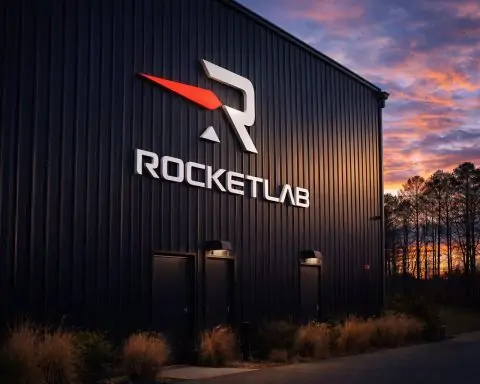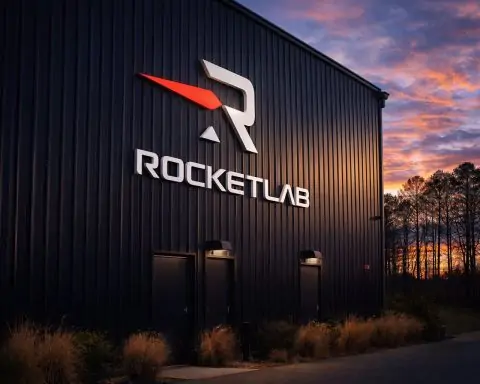Key Facts:
- US Government Shutdown: On Oct. 1, 2025, a U.S. federal funding lapse forced NASA to halt most civil servant activities and deferred dozens of science proposals. A Senate staff report had accused NASA of “illegally using” the President’s budget request to bypass Congress – a claim NASA flatly denies. (In practice, NASA has assured Congress it will stick to appropriated funds.)
- International Cooperation: ESA and South Korea’s space agency signed a Memorandum of Understanding at the Sydney IAC (Oct 1) to share tracking stations and collaborate on deep-space weather and remote sensing. (ESA Director Josef Aschbacher noted this “important moment for European space cooperation”.)
- Quantum Internet from Space: On Oct. 1, ESA announced a €50 million contract with Thales Alenia Space to design Europe’s first quantum-communications satellite (the SAGA mission). The goal is secure, unhackable key distribution; ESA’s Laurent Jaffart called it “advancing space communications … and Europe’s digital sovereignty”.
- Reusable Rocket Stage (Starship Rival?): Also at IAC Sydney, ESA signed a €40 million, 2-year deal with Avio (Italy) on Sept. 29 to develop a reusable upper-stage demonstrator. The effort “paves the way for Europe’s long-term future in space,” said ESA’s transportation chief Toni Tolker-Nielsen – effectively a European answer to SpaceX’s Starship.
- SpaceX Starlink Launch: SpaceX geared up for an early-October Falcon 9 launch of 28 new Starlink internet satellites (Group 10-59), originally scheduled Oct. 1. (The Oct. 1 launch was pushed to Oct. 6.) These small V2 Mini satellites will boost Starlink’s LEO constellation.
- Blue Origin’s Mars Mission: Blue Origin confirmed its second New Glenn rocket (NG-2) is being readied at Florida’s Cape Canaveral for mid-October liftoff, carrying NASA’s twin ESCAPADE probes to Mars. The 80-million-euro ESCAPADE mission (built by Rocket Lab) will study Mars’ magnetosphere. Blue Origin posted on social media: “ESCAPADE is at Astrotech and GS1 [the booster] is headed to LC-36 in early October. Next up is the vehicle hotfire mid-month with launch soon thereafter.”
- Next-Gen Satellite Internet: Viasat announced that ViaSat‑3 F2 (a 6-ton, high-throughput Ka‑band satellite) arrived in Florida on Sept. 30 ahead of its late-October launch on a ULA Atlas V. The satellite (built by Boeing) will “more than double” Viasat’s existing network capacity (adding over 1 terabit/sec). Viasat’s Space Systems VP Dave Abrahamian called the delivery “a big milestone…years in the making”. After final testing, F2 will launch to geostationary orbit for U.S., commercial and defense broadband service.
- China’s Deep-Space Probe: China’s CNSA released a milestone image Oct. 1 showing the Tianwen‑2 asteroid probe in flight, Earth visible in the distance. Launched May 29, 2025, Tianwen-2 is halfway (43 million km) to asteroid 2016 HO3 (a near-Earth quasi-satellite). CNSA reports all systems are normal; the probe will collect asteroid samples and later fly on to a main-belt comet.
- LEO Satellite Deals: Europe’s Eutelsat announced Oct. 1 that Greenland telco Tusass will use Eutelsat’s new OneWeb LEO constellation to bring broadband and critical connectivity across remote Greenland. OneWeb’s polar orbits ensure high-latitude coverage. “As Arctic nations seek to reinforce infrastructure, Eutelsat delivers a unique capability,” said Cyril Dujardin of Eutelsat. This underscores growing global interest in LEO constellations.
- Rocket Lab & SAR Constellation: On Oct. 1, Rocket Lab inked its largest-ever deal: 10 additional Electron launches for Japan’s Synspective SAR (radar-imaging) smallsat constellation. The total commitment is now 21 launches of Synspective’s StriX satellites through 2030, all from New Zealand. Rocket Lab CEO Peter Beck said a “reliable launch on a flexible schedule is essential to [Synspective’s] constellation build-out”, and Synspective’s CEO Arai Motoyuki praised Electron’s precision and rapid cadence.
- Space Defense Alliance: In a new demonstration Sept. 4–12 (reported late Sept.), US Space Command and UK Space Command conducted the first coordinated on-orbit maneuver under Operation Olympic Defender. A US satellite inspected a UK satellite to verify its status. U.K. Maj. Gen. Paul Tedman called it a “significant increase in operational capability”, and US Lt. Gen. Douglas Schiess said it “validated the interoperability that’s foundational to our collective defense”. This joint RPO (rendezvous proximity ops) sets the stage for deeper allied space cooperation.
In-Depth Report:
NASA and U.S. Space Policy: Shutdown Halts Many Operations
On Oct. 1, 2025, the U.S. government lapsed into a funding shutdown as federal appropriations ran out. All NASA civil servants (about 15,000 employees) were furloughed, and many agency offices and web services went offline. NASA’s Science Mission Directorate warned that proposal deadlines and solicitations would be set to “TBD” until funding is restored. SpaceFlight Now reports NASA officials immediately rebutted a critical Senate report – one claiming the agency was “illegally” relying on an unapproved budget blueprint – calling those allegations false. In practice, NASA says it will honor only congressionally appropriated funds once budgets are passed.
Because of the shutdown, routine NASA science missions face delays. For example, NASA’s Science website noted that lead investigators for new proposals are now unreachable and due dates will be postponed. (Once funding is back, proposers will be granted at least as many extra days as the shutdown lasted.) However, major commitments like the Artemis Moon program and International Space Station operations have bipartisan support, so top officials have pledged to continue critical activities as soon as budget issues are resolved.
Meanwhile, Congress is publicly sparring with NASA over long-term budgets. The Government Accountability Office (GAO) last year warned that NASA’s Artemis lunar plans may exceed current budget caps, potentially needing an extra $5 billion. The recent Senate staff report accused NASA of using the President’s budget request as a de facto authorization, a claim the agency dismissed as a misinterpretation of law. NASA’s Associate Administrator Amit Kshatriya told SpaceFlight Now that “the report contains information that is not accurate” and that NASA would comply with appropriations legislation.
All the while, NASA is closely watching the political picture. The shutdown began just as NASA personnel were at the International Astronautical Congress in Sydney, Australia. An October 2 note on NASA’s site bluntly stated, “Due to the lapse in federal government funding, NASA is not updating this website”. Still, the agency ensures the Artemis program continues under contingency plans. (Politico reported that NASA intends to keep Artemis progress moving even during a shutdown.)
Space Agency Initiatives: ESA Leads in Partnerships and Technology
In Europe, agencies were active despite the global funding tensions. ESA and South Korea’s KASA announced a new partnership on Oct. 1 (widely reported via ESA news) involving collaborative use of space tracking assets and data sharing, including on space weather. ESA head Josef Aschbacher said this deal “pushes forward our common endeavors” in satellite navigation, Earth observation and lunar exploration. Notably, the MOU was signed at IAC in Sydney, underlining the global nature of modern space projects.
Likewise on Oct. 1, ESA deepened its technology portfolio by signing two major contracts. At the European Quantum Forum in Brussels, ESA inked a €50 million contract with Thales Alenia Space (signed by Deputy Director-General Antonio Sturiale) to develop the SAGA quantum-communications satellites. SAGA will use entangled photons and laser links to deliver encryption keys from space – a key element of Europe’s secure connectivity strategy. As Laurent Jaffart (Thales) explained, this will “securely protect European communications” and keep the continent at the forefront of next-gen networks.
Meanwhile at the IAC, ESA and Italian launcher firm Avio announced a €40 million reusable upper-stage demonstrator project. This two-year study (contract signed Sept. 29) aims to prepare an upper stage that can re-enter Earth’s atmosphere and be flown again – a leap toward reusability analogous to SpaceX’s Starship concept. ESA Director Toni Tolker-Nielsen said the contract “addresses technological criticalities in the short-term” while building Europe’s long-term space infrastructure. The effort will leverage Italian advances in liquid propulsion and reentry tech, and could benefit future Vega-C or other Euro-rockets. (Space.com’s Andrew Jones noted ESA even released a Starship-like render of the concept to kick off the project.)
ESA’s other work included planning upcoming launches (e.g. new Galileo navigation satellites via Soyuz in October) and advanced studies. For instance, ESA is developing the “Pulse” mission management framework to streamline multi-Agency projects, and looking ahead to hypersonic vehicles like the “Invictus” spaceplane by 2031. (Artemis Accords discussions and civil programs also continued at IAC with partners from Australia, UAE, Canada, etc., reaffirming commitments to transparent exploration.)
China’s Mars/Asteroid Ambitions: Tianwen‑2 Milestone
On Oct. 1, China’s space agency highlighted the progress of Tianwen-2, its ambitious sample-return mission. A state media release (reported via SpaceDaily) showed a selfie from the probe, 43 million km from Earth. Launched May 29, Tianwen-2 is now halfway to asteroid 2016 HO3 (also called Kamo‘oalewa). The probe will collect pristine asteroid samples and is scheduled to reach the tiny quasi-satellite in summer 2026. Engineers report all systems “normal” and that onboard cameras, spectrometers and radars are actively mapping the asteroid. After asteroid sampling, Tianwen-2 will continue on to fly by main-belt comet 311P, performing remote-sensing that could yield insights into early solar-system chemistry.
This mission underscores China’s growing deep-space capabilities, mirroring NASA’s OSIRIS‑REx and upcoming CAESAR missions. While CNSA has not published extensive English-language updates, the Oct. 1 images and statements (earth visible behind the probe) signal confidence in Tianwen-2’s cruise phase. (China has also been quietly developing the Taiko-1 space weather satellite, lunar sample return, and preparing Tianwen-3 around 2028 for Mars samples.)
International Space Station and Crew Operations
The International Space Station (ISS) remains a focal point of both cooperation and caution. Notably, NASA and Roscosmos have quietly confirmed that each will continue flying crew members on the other’s spacecraft through 2025. This “integrated crew” approach – wherein some U.S. astronauts fly on Soyuz and some Russian cosmonauts on Crew Dragon – is intended to guarantee that at least one of each crew is trained on both U.S. and Russian modules [1]. A NASA spokesperson confirmed an amended agreement allowing one additional U.S.-Russia crew swap in 2024 and another in 2025 [2]. With ISS operations funded through 2030 by international consensus, this arrangement ensures backup access even as geopolitical tensions persist.
Meanwhile, routine station operations continue quietly. Russia’s new Progress cargo ships (Progress 92/93) delivered supplies earlier in September, and NASA’s Crew 10 Dragon is due to return soon. (Space.com reported in late September that Crew-10’s splashdown was imminent, following a 140+ day mission.) China’s Tiangong has also been active, with Shenzhou-20 crew recently upgrading debris shielding. Japan’s JAXA is preparing to launch its first HTV‑X cargo vehicle on Oct. 21 (H3 rocket) to resupply the ISS. That mission (under an updated H3 rocket design) will deliver 5.8 tons of food, experiments and station hardware – the heaviest load yet for Japan’s re-engineered cargo craft.
In summary, station crews from NASA, Roscosmos, ESA, JAXA, etc., press on with research while agencies juggle budgets. NASA did not furlough astronauts or contractors during the shutdown; ISS operations (life support, communications, ongoing experiments) will be maintained on a skeleton basis. But non-essential projects are on hold until the funding impasse clears.
Commercial Space Developments
Private companies were busy announcing deals and prepping rockets. Aside from SpaceX’s routine Starlink missions (the Oct. 6 Starlink launch and a planned Oct. 8 Kuiper flight round out early-month launches), two highlights stood out:
- Blue Origin / New Glenn: The West Coast launch company confirmed on Sept. 26 (Space.com) that its second New Glenn rocket is being outfitted for a mid-October launch. This NG‑2 mission will carry NASA’s twin ESCAPADE Mars probes – a rare commercial interplanetary launch. The probes (built by Rocket Lab) will head to Mars’ orbit to study space weather interactions. Blue Origin engineers are planning a hot-fire test of the 24-engine first stage (GS1) in mid-October, with liftoff following shortly thereafter. NASA’s $80 million ESCAPADE mission is now back on New Glenn after its original debut was postponed; a Viasat-built demonstration payload (NASA’s Communications Services Project) will hitch a ride as a secondary payload. New Glenn’s first launch in January 2025 was a success (despite an unsuccessful booster recovery), giving NASA the confidence to proceed with this interplanetary assignment.
- Rocket Lab / Synspective: On Oct. 1, Rocket Lab announced a blockbuster expansion with Synspective, a Japanese radar-satellite operator. The new agreement adds 10 dedicated Electron launches (from New Zealand) for Synspective’s StriX SAR constellation, bringing the total to 21 launches – the largest single-customer order in Rocket Lab history. Six of those satellites are already on orbit. CEO Peter Beck emphasized that “regular and reliable launch on a flexible schedule is essential” for constellation operators. Synspective’s founder Dr. Motoyuki Arai echoed the importance of timing, noting that Rocket Lab’s precision has enabled Synspective to “stay on schedule and achieve our mission objectives”. Each Electron flight will continue to deploy multiple 100‑kg SAR satellites to low Earth orbit, supporting global monitoring and data services.
- Eutelsat/OneWeb for Greenland: A non-launch industry development on Oct. 1 was the announcement that Greenland’s telecom operator Tusass is partnering with Eutelsat to use the OneWeb LEO broadband constellation. Tusass will leverage OneWeb’s polar-orbit satellites to connect rural communities, ships and emergency services across Greenland’s vast, infrastructure-poor terrain. Eutelsat CEO Cyril Dujardin said this “resilient, sovereign-grade connectivity” will support Arctic security, search-and-rescue and economic development. (Eutelsat recently merged with OneWeb, so this is a showcase for integrated GEO-LEO service.) For Musk’s Starlink and other constellations, this move highlights how LEO networks are becoming critical infrastructure, especially in extreme latitudes.
- ViaSat and Boeing: Also in satellite business news, Boeing and Viasat are finishing ViaSat‑3 F2’s prelaunch work. After 2 years of manufacturing and testing, the ultra-capable satellite arrived at Cape Canaveral on an Antonov cargo plane on Sept. 30. In quotes to Viasat’s press office, Boeing’s Michelle Parker noted the satellite uses 25-kilowatt solar arrays and all-electric propulsion for agility. Once deployed into GTO, ViaSat-3 F2 will use on-board maneuvers to reach GEO by early 2026. Viasat’s Abrahamian summed up the team’s enthusiasm: “This achievement represents the dedication and innovative spirit of hundreds of talented professionals,” and now they “turn our focus to getting F2 into orbit…to meet increasing demand for resilient, global satellite communications”.
- Starlab and LEO Stations: On the horizon, commercial space stations and tourism are stirring deals. Voyager Technologies (NYSE: VOYG), majority owner of Nanoracks’ Starlab LEO station concept, announced in late September that Vivace Corp. will build Starlab’s primary structural modules. Starlab, one of NASA’s three selected Commercial LEO Destination projects, has already received ~$217.5M in milestones funding. Voyager’s CEO Dylan Taylor said Starlab will ensure “a seamless transition from the ISS” and support government and commercial customers for decades. (By design, Starlab is modular and AI-enabled, targeting far larger habitable volume than ISS.) Although not on Oct. 1–2 exactly, this September item signals growing momentum in private stations.
Scientific Discoveries and Missions
Beyond operations and contracts, the first days of October saw some notable science updates:
- Venus Trojan Asteroids: A Space.com report (Sept. 30) highlighted a study that found a hidden population of dark, “nearly invisible” asteroids sharing Venus’s orbit. While these co-orbitals pose only a long-term impact risk, their existence changes our understanding of inner-solar-system dynamics. (The objects are too faint for current surveys, but models show they can drift into Earth-crossing orbits over ~12,000-year cycles.)
- Uranus Moon Ocean: Also in early October, astronomers using Hubble data announced evidence that Uranus’s moon Ariel may once have harbored a subsurface ocean. Elevated infrared emissions suggest a past layer of liquid water under Ariel’s icy crust, implying geologic activity. This finding (from Space.com’s Oct. 1 astro news) raises interest in future probes to the ice giants.
- Martian Biosignatures?: In planetary science, NASA’s Perseverance rover team reported finding possible organic/microbial signatures in a Mars rock dubbed “Cheyava Falls”. This raised a fringe question in the media: could China’s planned Tianwen-3 (around 2028) scoop up those drilled samples? Space.com covered this on Oct. 1, noting that if true, Perseverance’s cached sample (tube “Sapphire Canyon”) would dramatically up the stakes for Mars sample return. (NASA’s own Mars Sample Return architecture is struggling with costs and delays, so some scientists wonder if Chinese cooperation might accelerate analysis.) However, concrete answers await actual sample return, now years away.
- Space Weather Mission: A joint US-French microsatellite mission called DYNAMX launched into a 620-km orbit on Sept. 24 (Falcon 9) to measure the extreme upper atmosphere’s response to space weather and satellites. The mission, led by University of Michigan, was noted by space agencies as an important step in understanding atmospheric drag on satellites.
Outlook and Forecasts
Looking ahead from Oct. 2:
- Launches: Blue Origin’s NG-2 in mid-October (if successful) will make New Glenn the first U.S. rocket to reach Mars, on schedule for Dec. 2025 orbital insertion. SpaceX’s upcoming Starship flight (targeted Oct. 13) also looms large, though that’s slightly beyond our window. On Oct. 8, SpaceX is scheduled to launch its first Project Kuiper (Amazon) satellites, expanding LEO broadband competition. Arianespace’s Vega-C rocket may launch an Earth observation satellite in mid-Oct (after Ariane 6’s recent debut), and China’s Long March family will keep up their high cadence – a Long March 2D achieved its 100th flight on Sept. 30.
- Policies: The U.S. shutdown’s duration will dictate NASA’s near-term; for now, critical missions like Artemis I moon orbiter and Mars rovers remain funded by other accounts (e.g. launch windows already paid). Internationally, ESA member states will finalize the 2026 budget in December; climate and launcher budgets look set to rise slightly. The Artemis Accords are nearing their 5th anniversary; more countries (particularly in Asia-Pacific) are expected to sign in coming months.
- Technology: The resurgence of reusable launch tech (ESA’s project, Blue Origin’s recovery attempts, etc.) will be a key theme. On-orbit servicing and active debris removal missions (e.g. France’s ADAM mission, U.K.’s ClearSpace) may see contracts next year. Quantum communications is in rapid development (ESA’s SAGA, China’s QUESS tests) and will be a hot topic.
- Commercial Space: We may see new entrants: in mid-Oct SpaceX’s Starlink might surpass 5,000 satellites. The pending launch of Sierra Nevada’s Dream Chaser cargo ship (if on schedule) would be the first orbital flight of a reusable spaceplane since Boeing’s Shuttle in 1981. The Starlab/AXIOM private station projects are on critical paths – construction deals (like Vivace for Starlab) are just the start.
In summary, Oct. 1–2, 2025 saw a blend of space drama (US funding woes) and progress (international deals, company contracts, deep space milestones). Government agencies and commercial players are both charting bold paths: from reusable rocket stages in Europe to next-gen broadband satellites and interplanetary probes. Amid budget battles, the global space community continues cooperating on science and technology, as illustrated by joint maneuvers and shared station crews. The industry now watches closely as these early-October developments set the pace for launches and missions in the weeks ahead.
Sources: Authoritative releases and press reports from NASA, ESA, SpaceFlight Now, Space.com, SpaceDaily, BusinessWire, Reuters, and others, cited throughout.
References
1. www.space.com, 2. www.space.com









